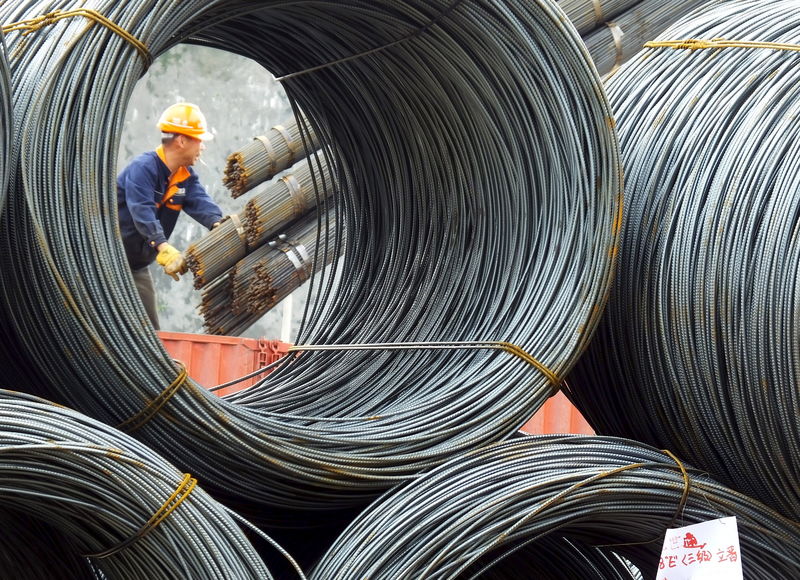By David Stanway
BEIJING (Reuters) - China is facing increasing international pressure to tackle a steel supply glut that has flooded global markets and left beleaguered overseas producers at risk of closure.
China produces half the world's steel but those hoping it will tackle its surplus capacity quickly will be disappointed, despite rhetoric from Beijing.
A steel production glut that has taken years in the making, will equally take years to resolve. The economy is growing at its slowest pace in 25 years and labour unrest is on the rise, a worry for the ruling Communist Party that fears the social unrest that millions of laid off steel workers could bring.
"Closures can not be completed overnight," said a person with ties to China's leadership. "Stability is the top priority."
China's fading economic growth has exposed the huge surplus capacity in steel making, leaving many producers with heavy losses that are adding to already high debts. Many see the solution in exports, which rose to a record in 2015, a major factor dragging global prices down to decade lows.
India's Tata Steel (NS:TISC) has blamed a flood of cheap steel imports, including from China, for a decision to pull out of Britain, putting 15,000 jobs at risk.
On Monday, more than 40,000 German steel workers took to the streets to protest against dumping from China, among other issues such as industry consolidation that they fear will cost them their jobs.
Hillary Clinton, widely expected to be the Democrat candidate in U.S. presidential elections this year, added her voice to the criticism, saying on Monday she would "impose consequences when China breaks the rules by dumping its cheap products in our markets."
"VICIOUS CIRCLE"
Official data shows China's production capacity is just over 1.1 billion tonnes a year although analysts estimate another 100 million tonnes are produced illegally.
Underlining the scale of problem facing Beijing, official figures suggest surplus capacity is some 300-400 million tonnes a year and exports in 2015 reached a record 110 million tonnes - about 10 times the annual steel output of Britain.
Although the China Iron and Steel Association and some steel executives have predicted that exports will fall in 2016, Chinese customs data on Wednesday showed shipments soared 30 percent in March from the same month a year ago.
Much of China's production glut was sparked by the country's debt-fuelled stimulus in 2009, when a government-directed 4 trillion yuan ($625 billion) was injected into the economy to ward off the global financial crisis.
The stimulus drove up steel demand by as much as 100 million tonnes in 2009 and encouraged producers to embark on a rapid capacity expansion using cheap credit.
"The steel mills were delighted - they didn't need to die, breathed a sigh of relief and also relaxed their vigilance towards overcapacity," said Liu Zhenjiang, the vice secretary-general of the CISA. "Those years created ingrained bad habits when it came to overcapacity."
China raised hope of a solution in February when it pledged to shut 100-150 million tonnes of old production capacity in five years, but actual production is expected to stay high as Beijing tries to minimise job losses and social disruption.
New plants have continued to come on line, and CISA has warned that capacity would increase further this year.
"The government is understandably very nervous about how exactly they're going to do this," said Geoffrey Crothall, communications director at China Labour Bulletin. "I think eventually pressure will build and they will have to go ahead. But you really shouldn't expect it to happen overnight."
CISA's Liu said existing mills are doing little to curb supply, noting they were trapped in a "vicious circle" in which they ramp up production at the first sign of price improvements.
Many firms engage in "hostile competition", raising production and slashing prices in a bid to outlast rivals, he said.
Government policy initiatives have not always helped either. One target to consolidate 60 percent of capacity in the hands of the 10 biggest steel enterprises helped spur a fevered round of expansions at mid-sized mills desperate to avoid being swallowed up.
"INGRAINED BAD HABITS"
Premier Li Keqiang reiterated on Monday Beijing intended to quicken steps to tackle the surplus production.
But the central government faces strong resistance from many local governments. Dozens of "zombie" mills cling to life thanks to the support of local governments terrified by the prospect of mass unemployment and carrying the steel firms' spiralling debts.
"You're not just shutting down the steel plants, you're shutting down their entire community," said Crothall. "That's why it's so difficult for the government just to put them out of business."
China's bankruptcy mechanisms also present massive challenges. Zhang Wuzong, chairman of Shiheng Special Steel Group, said China's bankruptcy laws offer little protection for executives, who could find their personal assets get frozen.
Xia Nong, head of the industry department of the National Development and Reform Commission, the state planner, said China's "survival of the fittest" mechanism remained inadequate.

"The fit are not strong and the unfit are not eliminated, and bad currency is still driving out good in the steel sector," he said.